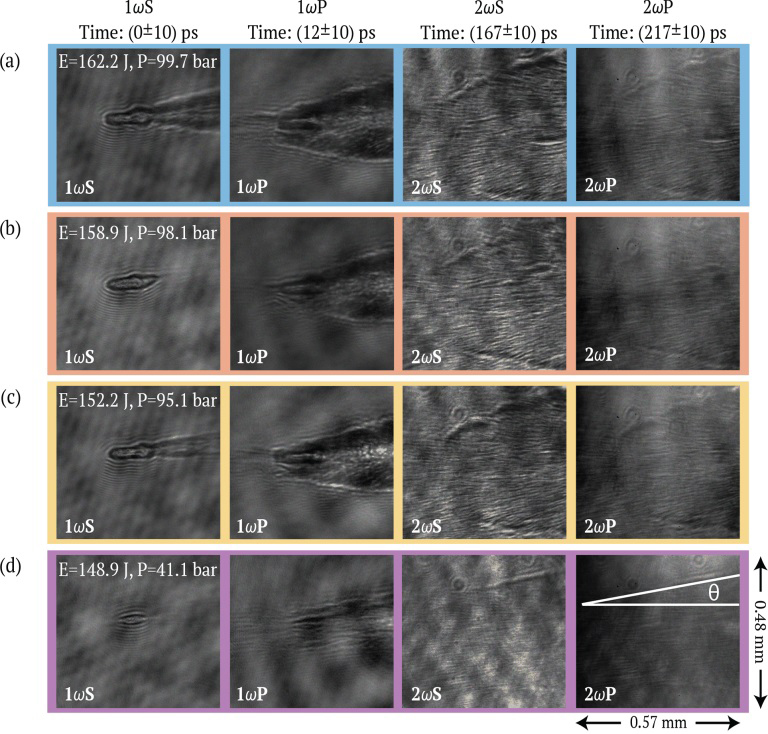Just how short is a picosecond? By definition a picosecond is 10-12 seconds, or one trillionth of a second. For some perspective, one picosecond to a second is what one second is to 31,688 years – which is to say almost no time at all. To plasma however, it is nearly all the time in the world.
Laser-plasma interactions are a point of interest as they offer a way to access exotic states of matter and can serve as a compact source of radiation. It is therefore essential that the underpinning plasma dynamics are understood.
A new system to set your sights on
The newly developed system consists of a multi-channel optical probe which is capable of spatial and temporal imaging of laser plasma interactions. The experiment demonstrates that fluctuations in the initial conditions of the laser and plasma result in substantial changes in the laser-plasma dynamics. The consequence of these small perturbations is that they “inhibit the reliability of optical probe measurements when obtained across repeated shots."
How does the system work?
A single laser pulse passes through the pulse generator, where four individual pulses are created and staggered in time. Each of these four pulses has a particular polarization and frequency; however each pulse can probe the same point in space. The delayed pulses are passed through a multiplexer where the separate pulses are made co-linear again. The pulses then probe the target. An image is formed from each of the four channels by passing the signal through a demultiplexer which spatially separates the pulses – which are then detected by an imaging system consisting of focusing lenses and CCD cameras.

Fig. 1 Process flow diagram of multiplexed optical probe concept. A single ultrashort laser pulse is divided into four separate laser pulses which are uniquely encoded by frequency and polarization. The four pulses are independently delayed in time and then spatially multiplexed to propagate co-linearly in order to optically probe a given point in space and time. The inverse process is then applied to spatially separate and form an image for each of the channels. This enables 2D spatial and picosecond temporal resolution over multiple frames with a single laser pulse.
"We can use this new optical probe to measure the evolution of many laser-plasma processes - from shock wave formation to intense laser-propagation - in a single laser shot, removing many of the difficulties related to experimental repeatability. This new technique will give us insight into new physics and enable us to verify existing models and simulations. The CLF's decades of experience in this topic and internationally leading laser systems made it possible to perform this complex experiment and open up this new approach." – Dr Ross Gray, Laser-Plasma Interactions Department of Physics, University of Strathclyde
The system was tested on Vulcan in an intense laser-plasma interaction experiment. The interaction was driven by a 1054 nm laser with 150 J pulse energy and the probe beam (480 mJ) was “picked off” the main beam and fired at a helium gas jet target – the density of which was carefully varied which was kept at different pressures. With images at different pressures, energies and times, it was clear to see the temporal evolution of the plasma channel.

Fig. 2 Shadowgraphy measurements of each probe output channel from the experiment for (a) E = 162.2 J, P = 99.7 bar (b) E = 158.9 J, P = 98.1 bar (c) E = 152.2 J, P = 95.1 bar, and (d) E = 148.9 J, P = 41.1 bar.
The laser pulse rapidly self-focuses in the plasma because the intense laser pushes electrons away from the center of the plasma channel causing the low intensity wings of the laser pulse to propagate faster than the peak. With the new optical probe it is possible to observe this happening in a single shot and the subsequent breakup of the plasma channel as it filaments.
The primary takeaway from these first results is the difference in temporal evolution for shots with very small fluctuations in initial parameters. For (a) – (c), the average gas pressure is 98 bar ± 2 bar and the average laser energy 158 J ± 5J. Here the early evolution varies substantially. Variance which does not appear correlated with higher laser energy and plasma density alone. Further insights are available in the full publication.
“This data highlights the importance of reproducible conditions to ensure reliability, especially when measurements are reconstructed from a series of consecutive shots."
The technique can be adapted to enable imaging of single-shot electron density evolution via time resolved interferometry. Further experimental work has been undertaken to increase the temporal resolution to femtosecond time scales.
Images used under open access from the publication: ZE Davidson et al. An optically multiplexed single-shot time-resolved probe of laser–plasma dynamics. Opt Express 27, no. 4 (2019): 4416-4423. doi:10.1364/OE.27.004416.
